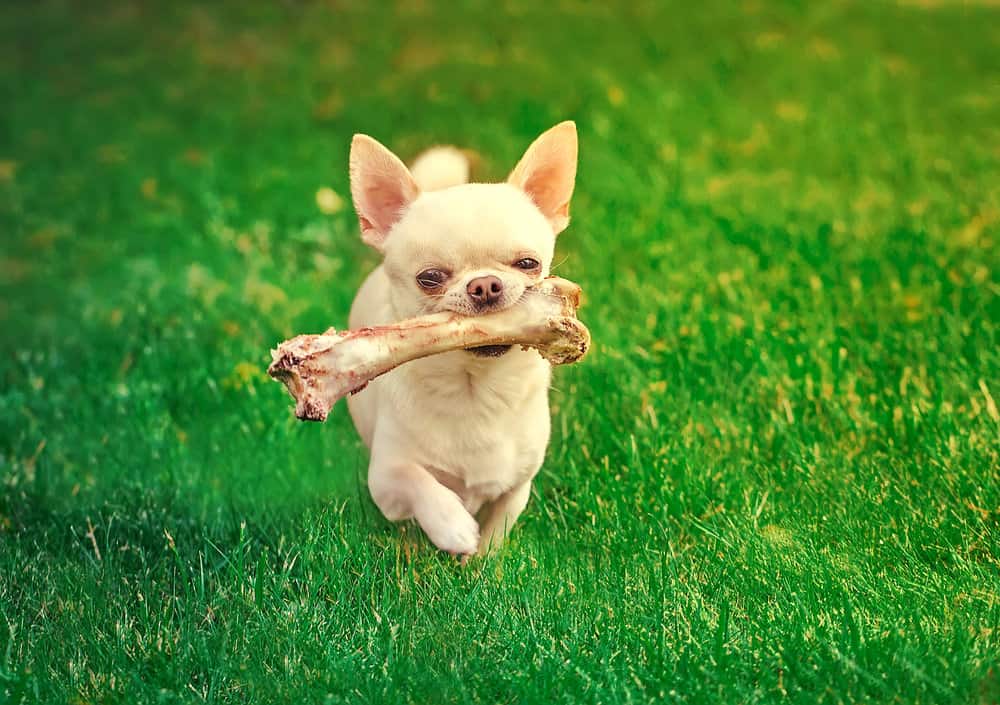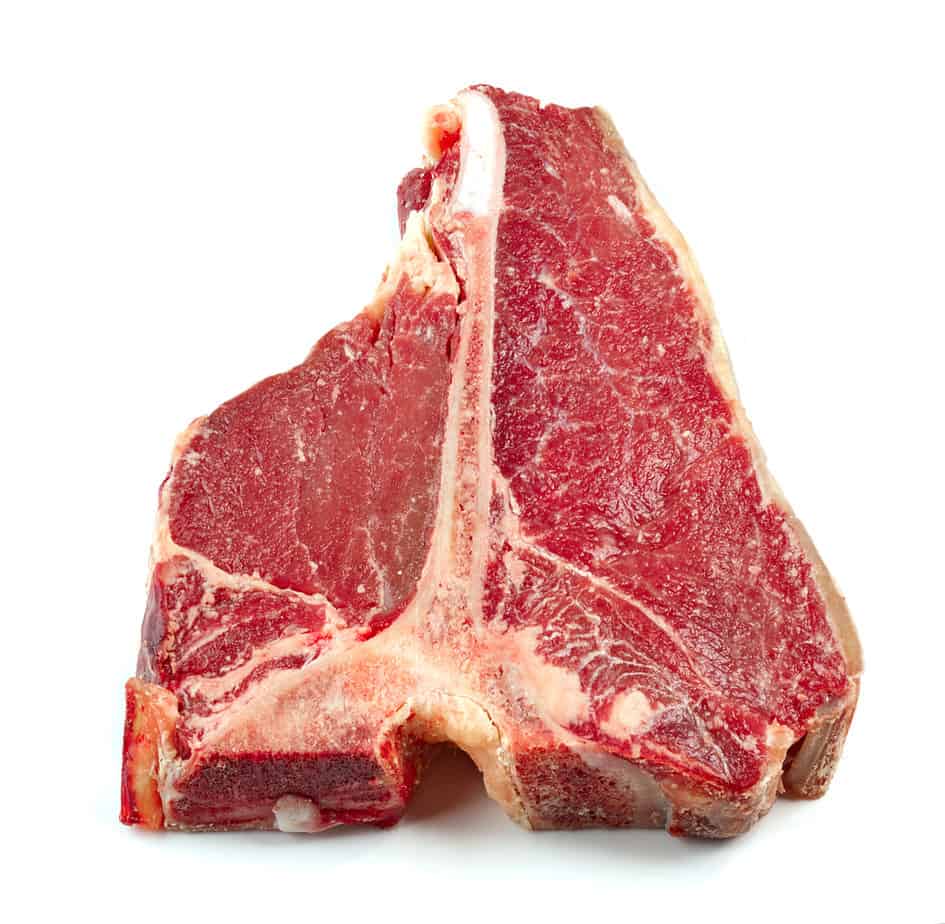You can start giving your puppy bones when he's 12 weeks old. You need to ensure the bones are raw and are about the size of his head. Also, avoid chicken and pig bones because they're brittle and can splinter.
You may have landed on this post while holding a ripped shoe or a leftover bone and wondering, “What age can I give my puppy a bone?
If your furry pet turned into a chewing monster, then it's time to get him some chew toys. A bone might be the first thing that comes to mind.
Are there any precautions to take before giving your dog a bone, though? That's what I'm about to discuss!
When Should I Start Giving My Puppy a Bone?

At around 12 weeks, your pup begins to lose his deciduous teeth and grow permanent ones. Your doggo should have his entire permanent set ready by 6 months of age.
During this time, you'll be doing both your buddy and yourself a favor by giving him something to chew on.
As they start teething, puppies will chew on everything and anyone, which is completely normal.
No one can blame those poor babies, as they experience severe discomfort in their gums while teething, and the discomfort is somewhat alleviated by chewing.
Besides, puppies explore their surroundings by feeling them, which they do by grabbing things with their mouths.
Bones can make a good chewing toy, but they aren't the best, as we'll see in a moment. If you do give your pup bones, just make sure they're about the size of their head and that they're raw.
Why Shouldn’t I Give Cooked Bones to My Puppy?
As a general rule, cooked bones are off the table, regardless of their size or the dog's age.
To explain, when you cook bones, they become more fragile. Thus, when it comes time for your pup to sink his teeth into it, it'll almost certainly break.
The broken pieces can be very sharp, causing severe damage and even death if consumed.
If your dog eats cooked bone fragments, he may develop the following health issues:
- Tonsillitis, mouth and tongue wounds
- Teeth fractures
- Cuts in the digestive system
- Choking
- Intestinal blockage
- Diarrhea
- Vomiting
- Rectal bleeding
Helpful Dog Training Resource:
For help with training your dog, you should take a look at The Online Dog Trainer by Doggy Dan. Doggy Dan is an expert Dog Trainer based in New Zealand. His online resource contains Hundreds of Excellent Dog Training Videos that will take you step-by-step through the process of developing a healthy, happy well-behaved dog.
What Kind of Bones Should I Give My Puppy?
The criteria for a safe bone for your doggo are comprised of three factors:
- Size
Get your puppy a bone that’s at least the size of his head. That's a precautionary measure to make sure he won’t be able to swallow it. This implies that any small bone is a choking hazard.
- Hardness
Make sure the bone you get isn't brittle and won't splinter and harm your furry friend. At the same time, the bone shouldn't be so hard that it fractures his teeth or damages his jaw.
- Source
The origin of the bone can make all the difference. Because the nature of bones in poultry, pigs, cows, and other animals varies.
There are some that are safe for your canine and others that you should avoid. Consequently, I've compiled a list of bones that are a green light for your pup to chew on.
Safe Bones
- Cow heart bones. They're not as hard as actual bones, making them an excellent chew for your puppy.
- Bison knuckle and femur bones. These large bones are ideal for large dogs such as Mastiffs and German Shepherds.
Bones to Avoid:
- Poultry bones. This includes chicken and turkey bones, which are small and easily splinter.
- Pig bones. They're brittle and easily breakable, and they're more likely to harbor bacteria.
- Ribs. Any rib bone, regardless of its source, can become lodged in your dog's throat.
- Hard marrow bones. This includes T-bones and lamb cutlets as they can be tough on your puppy's mouth.

What Are the Pros and Cons of Giving Your Puppy a Bone?
A raw bone, like everything else, has benefits and drawbacks when given to your dog, and we're about to go over both.
Benefits of Raw Bones
On one hand, introducing a bone to your pup can be rewarding in a variety of ways, including:
- Alleviating discomfort in his gums while teething.
- Enhances his dental health by removing tartar and bacteria from his teeth.
- High in nutrients such as calcium, protein, and phosphorus.
- Providing him with mental stimulation.
- Reducing his destructive chewing behaviors.
Drawbacks of Raw Bones
On the other hand, giving your doggo a raw bone can lead to serious issues such as:
- Causing disease in both humans and dogs as a result of bacterial contamination (bones are a breeding ground for bacteria and parasites).
- Broken or fractured teeth due to the hardness of the bone.
- Mouth and throat injuries if the bone has sharp edges.
- Bones are high in fat, so chewing on them excessively can lead to diarrhea, weight gain, or worse, pancreatitis.
- Choking or intestinal blockage if he breaks a piece and swallows it.
Helpful Dog Health Resource:
Note: Our Health is #1 Priority. It should be no different for your dog. But you need to help him. The Ultimate Guide to Dog Health is the answer. This handy guide will help you recognize the symptoms of the health problems above. Get the knowledge to stay ahead of these terrible issues that can rob your lovely dog from vigor and life. Help your friend make it to 14 yrs+ without pain and suffering.
How to Give Your Puppy a Bone Safely
Here's a comprehensive guide to safely introducing raw bones to your pup:
- Monitor Play Time

In fact, this rule applies to any toy, not just bones. Always keep an eye on your dog while he's playing with toys or chewing on bones so that you can prevent any choking hazards.
- Limit Chew Time
Your puppy should chew on the bone for no more than 10 to 15 minutes. Moreover, he should only chew on the bone twice a week, not every day.
Anything longer can cause gum bruises or wear out his teeth. Again, bones are also high in fat, so he shouldn't eat them a lot.
Remember to distract him with another toy that he enjoys playing with while removing the bone.
- Clean and Freeze
To avoid bacterial contamination, always wash your hands and the surfaces where the bone was placed thoroughly. You should also freeze it after playtime to slow bacterial growth.
However, you must let it cool before giving it to your dog again so that it’s not too hard on his teeth.
- Switch Up
The fresher the bone, the better because as bones age, they begin to harbor more bacteria. Thus, it's best to discard the bone after three to four days.
If you want, you can replace the bones with other safer chew toys and watch how he reacts to them.

Paul has been creating content for the dog niche for many years. The information he shares comes his first hand experience growing up in dog lovers household and then owning multiple dog breeds of his own as an adult. Paul enjoys doing the hard research to collect, analyze and present our dogtemperament.com readers with the best answers to their questions.